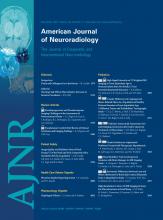Abstract
BACKGROUND AND PURPOSE: Little is known about the pathological mechanism or the anatomic and functional imaging features related to the clinical manifestations in patients with brain AVM. The purpose of this pilot study was to describe the pattern of whole-brain PCT abnormalities in brain AVMs and their potential to differentiate underlying pathomechanisms.
MATERIALS AND METHODS: Whole-brain PCT performed on a 320−detector row CT scanner was analyzed in 18 patients with untreated brain AVMs. The patterns of perfusion abnormalities on CBV, CBF, and MTT maps were analyzed and were related to clinical presentation and cerebral angiography.
RESULTS: The presenting symptoms were seizures (n = 5), focal neurologic deficit (n = 5), hemorrhage (n = 4), chemosis (n = 1), and none (n = 3). Three types of extranidal brain parenchymal perfusion abnormalities were noted. Decreased CBF, CBV, and MTT (pattern 1, “functional” arterial steal) were identified in 8 patients. Seizure was the most common presenting symptom in these patients (n = 5). Decreased CBF and CBV, and increased MTT (pattern 2, “ischemic” arterial steal) were noted in 4 patients. Focal neurologic deficit was the most common presenting symptom for these patients (n = 3). Increased CBV and MTT (pattern 3, venous congestion) were seen in 5 patients with presenting symptoms of neurologic deficit (n = 2), seizure (n = 1), hemorrhage (n = 1), and chemosis (n = 1). In 2 patients, pre- and posttreatment PCT was performed, which showed improvement of perfusion abnormalities.
CONCLUSIONS: Whole-brain PCT shows different patterns of perfusion abnormalities in patients with brain AVM. These perfusion patterns may discriminate the different pathologic mechanisms involved in these malformations.
- © 2011 by American Journal of Neuroradiology
Indicates open access to non-subscribers at www.ajnr.org












